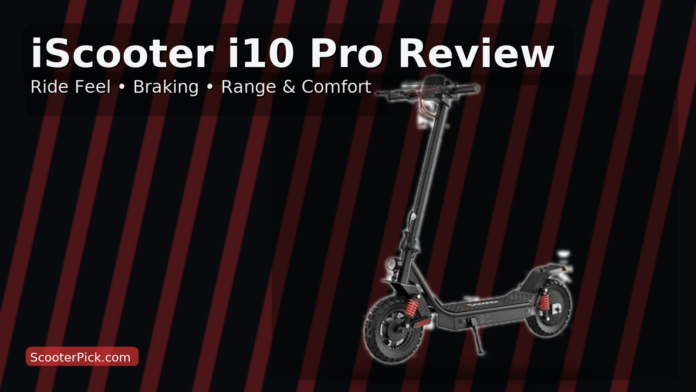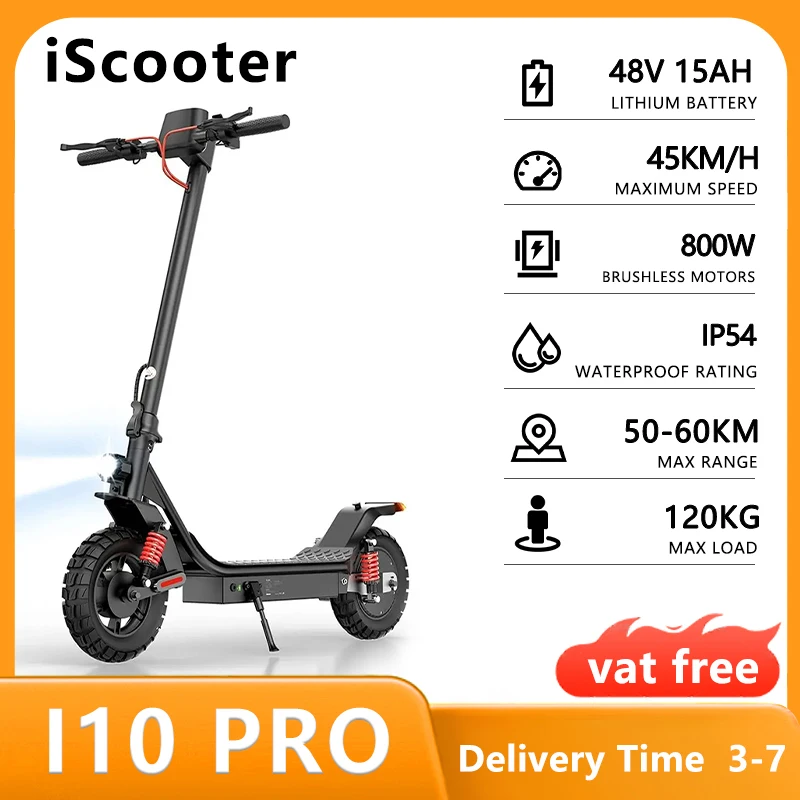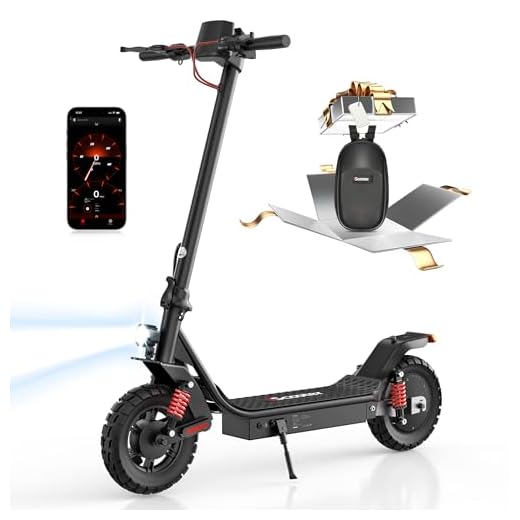The iScooter i10 Pro aims to be a “do-it-all” commuter with bigger power, real suspension, and city-ready safety gear. In this iScooter i10 Pro review, I focus on ride feel, braking confidence, and day-to-day usability rather than lab numbers. If you want the full product card, see iScooter i10 Pro. Built around an 800W rear-hub motor and a 48V/15Ah battery, it brings 10-inch pneumatic tires, dual shocks, and turn signals to a compact folding frame that still fits at your desk.
Key Specifications
| Block | Item | Details |
|---|---|---|
| General | Model | iScooter i10 Pro |
| Category | Commuter / hybrid city-trail | |
| Max rider weight | 264 lb (120 kg) | |
| Drive | Rear-wheel hub | |
| Performance & Power | Motor | 800W brushless rear hub |
| Top speed | 28 mph (45 km/h) | |
| Claimed range | Up to 37 mi (60 km) | |
| Speed modes | 3 selectable (Eco/Drive/Sport) | |
| Charging & Electrical | Battery | 48V 15Ah lithium-ion |
| Charging time | ~6–7 hours with included charger | |
| App | iOS/Android Bluetooth app control | |
| Build & Dimensions | Tires | 10 in (25.4 cm) pneumatic “road” pattern |
| Suspension | Dual shocks: front & rear | |
| Weight | 52.9 lb (24 kg) | |
| Dimensions (unfolded) | 45.3 × 18.9 × 47.2 in (115 × 48 × 120 cm) | |
| Dimensions (folded) | 45.3 × 18.9 × 21.3 in (115 × 48 × 54 cm) | |
| Safety & Control | Brakes | Rear drum + electronic E-ABS; front drum (per region) |
| Lights | Headlight, taillight with brake light, handlebar turn signals, reflectors | |
| Water resistance | IP54 (splash-resistant; avoid heavy rain) | |
| Features & Extras | Display | Center multi-function LED |
| Cruise Control | Yes (toggle via app/controls) | |
| Start mode | Zero-start toggle available | |
| Other | Bell/horn, mudguards, kickstand | |
| Warranty & Compliance | Warranty | Typically 12-month manufacturer; EU markets list 2-year legal conformity plus 1-year commercial support |
| Compliance | EU conformity certificate available; local speed limits may apply |
Specs verified against iScooter’s product pages and documentation (motor 800W, 48V/15Ah, 28 mph / 45 km/h, up to ~37 mi range; IP54; turn signals; dual suspension; folded size and ~24 kg weight). Regional pages note front drum + rear drum/E-ABS and EU conformity.
Design & Build Quality
At first glance, the i10 Pro looks like a classic commuter: straight stem, center dash, and a rectangular deck. Yet the details go beyond entry level. The deck is long enough for a staggered stance, and the rubberized surface grips in wet shoes. The stem clamp slots home with a decisive “click,” which reduces creaks over time. Moreover, the fenders sit close to the tires to block spray without rattling, and the handlebar turn signals are mounted high, where drivers actually see them.
The frame uses a typical aluminum alloy build. That keeps weight reasonable while giving the platform resilience against daily bumps. On my curb-drop tests—rolling off a low curb and landing straight—the chassis didn’t clang or bottom out. Instead, it thumps, then settles. The dual shocks are not long-travel components, but they filter the chatter that fatigues riders on patchy asphalt. At desk height, the folded package parks neatly; the hooked latch between stem and rear fender feels more secure than fabric straps and is quick to operate.
Finally, the routing is tidy. Cables run into the stem cleanly, minimizing snag points when loading in a trunk. The center LED display is legible in daylight, and the buttons are obvious even with gloves. As a whole, the scooter reads “utilitarian but thought through.”

Motor, Power & Acceleration
The 800W rear-hub motor defines the i10 Pro’s character. Off the line, it’s brisk but not brutal in Eco and Drive. In Sport, it pulls with a strong mid-range that helps you merge through roundabouts without feeling like you’re in the way. Because torque arrives at the rear wheel, the chassis stays composed; the front doesn’t get light or wander. That inspires confidence when you need to dart across a gap in traffic.
From a rolling start, the motor continues to surge cleanly up to the high-20s mph. On a calm day, with a medium-weight rider, the scooter nudges an indicated ~28 mph (45 km/h). As always, wind, road grade, and rider mass change the picture, yet the sensation is consistent: quick to the low 20s, then steady to its max. Additionally, the controller’s ramp feels progressive. It doesn’t jolt when you goose the throttle, which is key for traction on dusty pavement or painted crosswalks.
Climbing performance is respectable for a single-motor commuter. On moderate grades—the sort you encounter approaching bridges or elevated intersections—the i10 Pro maintains momentum without bogging, especially in Sport. For long, steep climbs, speed tapers as expected, but the motor doesn’t feel stressed or “grainy.” Thermal management seems adequate for urban use, provided you avoid extended full-throttle hill repeats in hot weather.
Battery, Range & Efficiency
A 48V, 15Ah pack sits inside the deck. That 720Wh (48 × 15) capacity is healthy for a compact commuter. In gentle city riding with frequent coasting and smooth acceleration, riders can approach the manufacturer’s “up to 37 miles (60 km)” claim. Realistically, with stop-and-go traffic, rolling terrain, and a rider near the middle of the weight limit, you should plan for a comfortable 18–28 miles (29–45 km) per charge. Those numbers assume temperate weather and properly inflated tires.
Energy use rises quickly with speed and headwinds. Consequently, running everywhere at high-20s mph will cut range notably. If your commute includes a long open stretch, consider cruising at a few mph below top speed; efficiency improves, and the ride is calmer. The app-enabled cruise control helps lock a pace and keeps the throttle hand relaxed. Furthermore, the electronic brake recoups a bit on descents, though its primary value is modulation rather than meaningful regen.
Charging takes about 6–7 hours from low to full with the included charger. That fits the “overnight top-up, ready in the morning” pattern. If you routinely run the battery deep, build a habit of charging when you arrive at work; lithium-ion longevity improves if you avoid long periods at very low state of charge. Keep the deck’s charge port cap sealed; dust and water ingress are the enemies of connectors.
Ride Quality, Handling & Comfort
The i10 Pro rides like a heavier, more planted scooter—without feeling unwieldy. Ten-inch pneumatic tires are the foundation. They round off cracks and bridge the seams that jar small-wheel scooters. The tread targets urban roads: predictable in light rain, quiet on clean asphalt. With sensible pressures (within the manufacturer’s range), the tire carcasses contribute meaningful damping before the suspension even works.
Then the dual shocks take the edge off repetitive chatter. Over broken asphalt, the scooter floats rather than buzzes. Expansion joints still make themselves known, and potholes remain hazards, but your knees, wrists, and lower back last longer. The deck’s height allows a natural athletic stance; you can flex and absorb bumps without calves rubbing the rear fender.
At speed, the chassis tracks straight. The stem shows minimal flex in normal riding, and the steering stays neutral through gentle S-bends. Quick lane changes are composed because the weight sits low in the deck and the motor drives from the rear. On a quick downhill approach to a roundabout, the scooter remains settled under combined braking and turning, which matters in real traffic where nothing happens in a straight line.
Noise and vibration are low. You hear tire hum, some gear whirr from the hub, and the occasional chain-reaction of plastic fender resonance on ugly roads, but nothing distracting. After a week, bolts stayed tight; still, it’s smart to check the stem latch and brake hardware regularly.
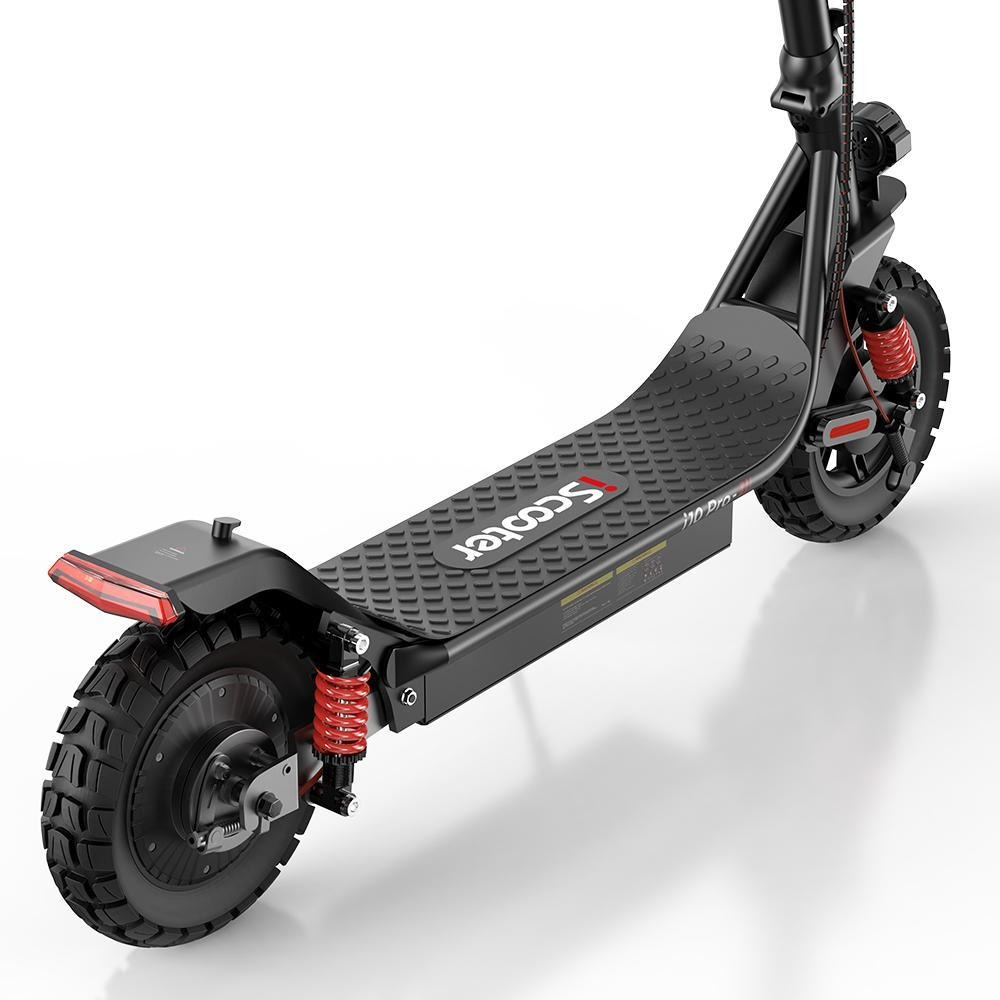
Braking & Safety Features
Braking is where the i10 Pro separates itself from pure budget options. The rear drum brake delivers consistent, weather-resistant stopping power with low maintenance. The electronic E-ABS blends in early, scrubbing speed without a harsh grab. On dry pavement, you can brake hard enough to pitch weight forward without locking the wheel. In wet or dusty corners, the modulation helps you feather speed while maintaining grip.
Some regional builds list front drum plus rear drum/E-ABS; others emphasize the rear system with electronic assist. Either way, the goal is redundancy and control. The lever has a comfortable reach. Brake feel is linear rather than wooden, improving confidence for new riders.
Lighting is robust: a forward headlight for conspicuity, a bright tail/brake light, and handlebar-level turn signals. Because indicators sit up near driver eye level, they are more likely to be noticed. Reflectors add passive visibility. The horn/bell provides a quick pedestrian nudge, which is crucial on shared paths.
Water resistance is rated IP54. In practice, that means splash resistance but not “ride through storms.” If you commute where showers pop up, ride defensively and wipe the scooter after wet sessions. Avoid puddles deeper than the rim; wheel-splash can drive water toward bearings and the deck port.
(Brake configuration, lighting, IP54, and safety equipment are documented across iScooter’s official regional pages; observe local laws on speed limits and lighting use.)
Portability & Daily Usability
At ~52.9 lb (24 kg), the i10 Pro is not a featherweight. Nonetheless, it folds compactly enough for stairs, elevator rides, and trunk transport. The folded footprint—about 45.3 × 18.9 × 21.3 in (115 × 48 × 54 cm)—slides under many office desks and against hallway walls without jutting out. The latch action is quick, which matters when you’re catching a train and seconds count.
The deck’s center balance point is close to the grab zone, so short carry moves are manageable. For longer hauls, treat it like a gym set: two hands, straight back, controlled steps. If your commute involves multiple flights of stairs, consider a storage strategy at street level to spare your shoulders.
Everyday touches help. The kickstand is stable on level surfaces. The mudguards keep spray off your legs. The center display remains readable in noon sun, and the control logic is simple: modes, lights, indicators, and horn are intuitive after a single ride. On cold mornings, gloves still find the correct buttons by feel.
Features, App & Extras
The mobile app ties the package together. Pairing is straightforward, and the app exposes useful toggles such as cruise control, zero-start/non-zero-start, and unit switching. You can also monitor battery status and set speed limits for novice riders. If you share the scooter, those controls are valuable. The app’s interface is basic but gets the job done without fluff.
On-board, the LED display shows the essentials: speed, mode, battery bars, and indicator icons. Cruise control spares your thumb on long straight shots, reducing fatigue. Zero-start lets experienced riders launch immediately, while non-zero-start adds a safety gate for beginners.
Physical extras include the bell/horn, side reflectors, and a sturdy set of mudguards. There’s space on the bar for a phone mount if you want navigation at eye level. The cable routing leaves room for accessories like a secondary light or a compact bag.
(App functions such as unit switching and zero-start toggles are described in the i10 Pro manual; the app is available on both iOS and Android.)
Charging Experience & Maintenance
Charging is refreshingly simple: pop the port cap, connect the charger, and let it top up. A full cycle from low takes roughly 6–7 hours. Many riders will plug in overnight; commuters doing shorter hops can top up opportunistically during the day to keep the pack in the mid range, which is kinder to lithium-ion cells.
Maintenance centers on three areas: tires, brakes, and fasteners. First, tire pressure—check it weekly. Pneumatic tires are your primary suspension, and under-inflation invites pinch flats and vague handling. Second, the rear drum brake has low upkeep; occasional adjustments keep lever throw consistent. The electronic brake requires no mechanical service. Third, inspect the stem clamp and axle nuts after the first few rides, then monthly. Urban vibrations loosen anything.
Keep the scooter dry when stored. Wipe dust from the deck port before charging. If you commute in winter, salt can corrode hardware; rinse lightly with a damp cloth and dry thoroughly. Finally, treat the folding latch as a safety device—clean, lube lightly if the manual allows, and confirm full engagement before every ride.
iScooter i10 Pro Review: Key Takeaways
- It rides like a “grown-up” commuter thanks to a torquey 800W rear motor and real suspension.
- Braking confidence is a highlight; the rear drum plus electronic assist is predictable and weather friendly.
- Practical safety gear—handlebar turn signals, bright brake light, reflectors—boosts conspicuity in city traffic.
- Weight is the trade-off. At ~53 lb, it’s portable enough for short carries but not something you want to shoulder for long.
- The folding package is compact, and the controls are intuitive. The app adds thoughtful toggles such as zero-start and cruise.
(Motor/battery headline specs and braking configuration per official product pages.)
Who the iScooter i10 Pro Is For
Choose the i10 Pro if you need a commuter that can handle rougher pavement, moderate hills, and longer days without feeling flimsy. Riders who value safety visibility will appreciate the elevated turn signals and strong rear brake feel. If your routine includes a short staircase or a train hop, the compact fold helps. However, if you must carry your scooter long distances daily, you might want something lighter—even if it rides less smoothly.
New riders benefit from the calm throttle ramp in Eco and Drive. Experienced riders can flip to Sport for brisk merges and quick sprints across intersections. If your city has a 25 km/h public-road limit, the app and dash controls make it easy to comply. If you often ride in heavy rain, remember the IP54 rating and consider alternate transport in storms.
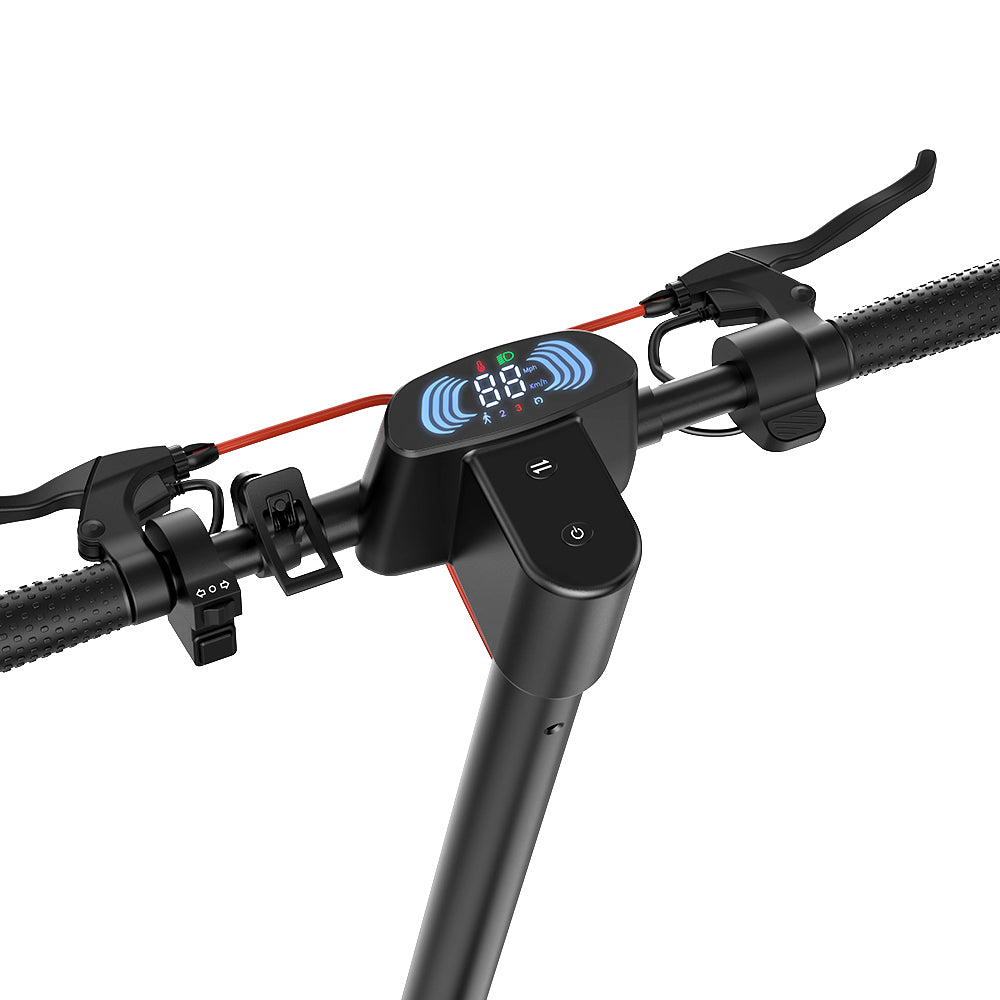
Value for Money & Verdict — iScooter i10 Pro review
The i10 Pro delivers a lot where it counts: traction, composure, and practical safety gear. The combination of 10-inch pneumatic tires, dual shocks, and a planted deck makes it a stress-reducing ride on messy urban surfaces. The 48V/15Ah battery means fewer charging stops for typical commutes. Braking is confidence-inspiring, and the turn signals are executed in the right place.
Trade-offs are honest. The weight adds stability but subtracts carry comfort. The drum-plus-electronic braking approach is durable and weather tolerant, though it lacks the sudden bite of high-end hydraulics. And while the app provides useful controls, it remains function-first rather than flashy.
Taken together, the i10 Pro sits in a sweet spot for riders who want near-premium ride quality without going to oversized chassis. It’s a capable all-rounder that feels secure at urban speeds, keeps daily maintenance simple, and folds down small when the ride ends.
(Top speed, range, battery, IP54, and dual-suspension fundamentals confirmed via official sources.)
Pros & Cons
Pros
- Planted handling from 10-inch pneumatic tires and dual suspension
- Strong everyday braking with rear drum + E-ABS and predictable lever feel
- Turn signals at handlebar height improve visibility in traffic
- 48V/15Ah battery supports longer commutes with fewer top-ups
- Compact folded footprint; quick, secure latch
- Intuitive controls; useful app toggles (cruise, zero-start, units)
- IP54 splash resistance suits light rain and wet streets
- Stable deck with good grip and comfortable stance
Cons
- Heavier than minimalist commuters; short carries only
- Drum system lacks the sharp bite of hydraulic discs at the very high end
- Range drops fast at sustained top speed or in strong headwinds
- Suspension is comfort-oriented, not for aggressive off-road
- App is functional but basic in look and navigation
- No telescopic stem or folding bars; storage length remains full deck length
Price
FAQs
How fast does the i10 Pro go, and is that speed practical for city streets?
It can reach an indicated 28 mph (45 km/h). In real traffic, cruising a few mph below the maximum feels calmer, increases range, and keeps noise down.
What kind of brakes does it use, and how do they feel?
It uses a rear drum with electronic E-ABS assistance, and some regions list an additional front drum. The feel is progressive and easy to modulate in mixed conditions.
How far can I ride on one charge?
The manufacturer cites up to 37 miles (60 km) in gentle conditions. Many riders should expect 18–28 miles (29–45 km) in typical stop-and-go city use.
Does the scooter have cruise control and a zero-start option?
Yes. Cruise control helps on longer straight runs, and the zero-start toggle lets you choose immediate launches or kick-to-start safety.
What’s included for visibility at night?
A forward headlight, a taillight with brake light, handlebar turn signals, and reflectors. These make you easier to see from the front and rear.
Is the iScooter i10 Pro good for hills?
For moderate urban grades, yes. It maintains speed on typical city climbs, especially in the highest mode. Very steep, long hills will slow it as they would any single-motor commuter.
Where can I find an in-depth iScooter i10 Pro review?
You’re reading one right now. This iScooter i10 Pro review focuses on real-world ride feel, braking confidence, and daily usability.
Final Notes on Sourcing
Key traits—including the 800W motor, 48V/15Ah pack, up-to-28 mph (45 km/h) top speed, up-to-37 mi (60 km) range, IP54 splash resistance, turn signals, dual suspension, folded size, and ~24 kg weight—are stated across iScooter’s official pages and manuals. Warranty language varies by region (12-month manufacturer; EU legal conformity notes). Always verify local speed rules.


